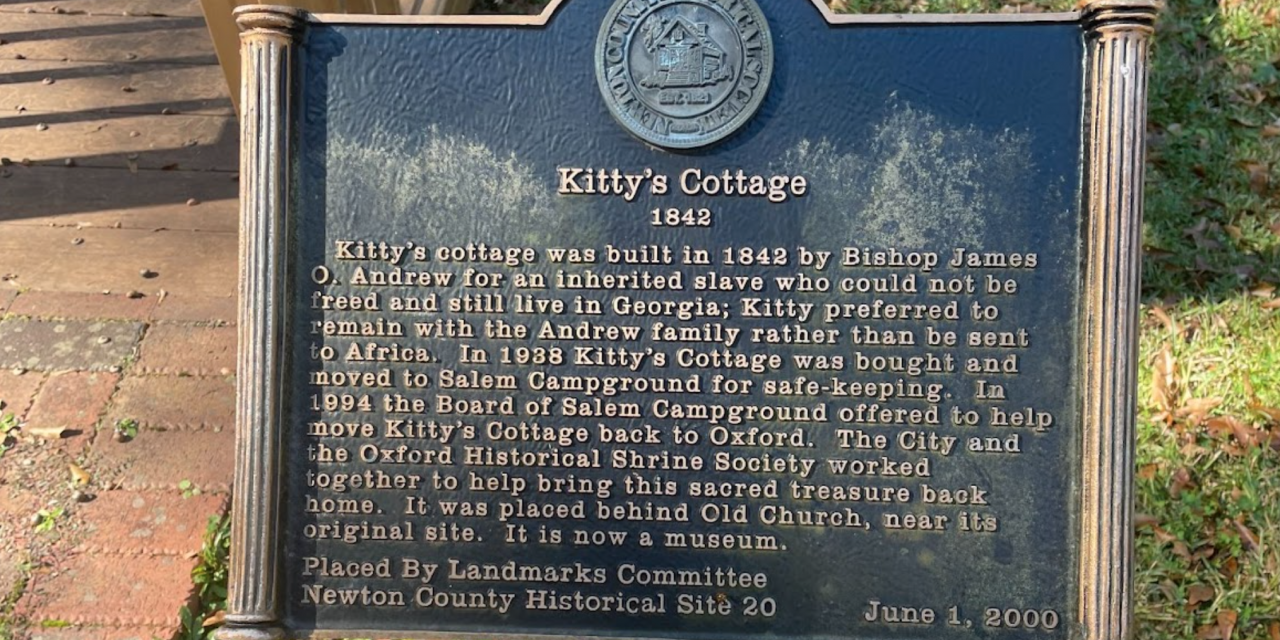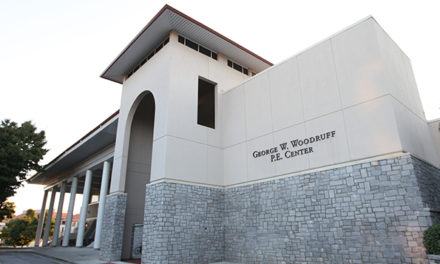The daily life of an Oxford College student is haunted by relics of the Confederacy.
A confederate statue in Covington Square, the heart of the nearby town, watches over students driving to the Oxford campus.
Students attend classes and activities in Phi Gamma Hall and Tarbutton, buildings constructed with slave labor.
The nature trail behind the Williams gym leads to a cemetery with at least 32 Confederate soldiers, with an obelisk that reads “Our Soldiers.”
Another nature trail leads to Kitty’s Cottage, a house built for Catherine “Kitty” Andrew Boyd who was enslaved at 12 years old.
These unavoidable encounters are troubling for many students, who said they are concerned with what they see as the University’s attempts to sanitize these relics. To rectify this history, students have taken a large role in advocating for acknowledgement of Confederate history at Oxford via planning symposiums, drafting initiatives and speaking to campus leadership about their concerns.
‘Our Soldiers’: Impacts of the Confederate cemetery
The cemetery on campus is a remnant from when several buildings at Oxford served as makeshift hospitals for soldiers on both sides of the Civil War. At the end of the war, the cemetery was built to house the graves of Confederate soldiers not claimed by their families. The cemetery currently lies about 100 yards west of the Oxford College gym. Union soldiers who died in the same hospitals are buried in a common grave in the Oxford Town Cemetery, located just under a mile from the campus.
Mayor of the City of Oxford David Eady wrote in a Jan. 13 email to the Wheel that Emory University owns the property on which the Confederate cemetery sits. Some students have expressed discomfort with its close proximity to the campus, saying the cemetery can be difficult to avoid.
“I found the cemetery while exploring when I first came to campus, and it was not a good feeling,” Oxford Men of Color President Devin Gee (22Ox) said. “I felt like I couldn’t really belong at Oxford with the cemetery here.”
Assistant Vice President of Marketing and Communications Laura Diamond told the Wheel in a Dec. 10 email that “the cemetery is protected by state law and includes gravestones federally protected by the U.S. Department of Veterans Affairs.”
Gee worries that its presence will lead to the desensitization of the Confederacy’s racist past. This has become evident with students using the cemetery as a backdrop for photos and professors taking their classes there.
“More needs to be done either in terms of general announcements or different signs outside the cemetery to avoid that desensitization that leads to constant inappropriate actions with people in the graveyard,” Gee said.
Diamond said the University is actively working to better acknowledge its history. “Emory continues to examine our Civil War-era history while also working to address contemporary issues on race and inequality,” Diamond wrote.
Former University Historian Gary Hauk, who has written about Emory’s relationship with the Confederacy, called the wording of the obelisk “misleading” as it doesn’t represent the individuals who fought for the United States during the Civil War.
“Whose soldiers are they? They’re not ‘our’ soldiers,” Hauk said. “They’re not soldiers of the United States. They were the soldiers of the Confederacy. Perhaps a different sort of statement needs to be made there.”
Mark Auslander, a former faculty member at Oxford College and current visiting research scholar in anthropology at Brandeis University (Mass.), has written extensively on the history of enslaved people in the antebellum period at Emory. He said the cemetery represents a trend of a “cult of remembrance” for the Confederacy in the South, with an obelisk fondly claiming soldiers — who have no relationship to the University other than their death on campus — as “ours.”
“It tells you something about this long-time spirit of a certain kind of white nationalism that permeated a lot of the University,” Auslander said.
The wording on the obelisk also does not commemorate the Black members of the United States Colored Troops, who gave their lives fighting for the union in Georgia, Auslander explained. Further, the Union soldiers in the Oxford City Cemetery are not referenced as ‘our soldiers.’
“‘Our’ means Confederate,” Auslander said. “It means white. It means everybody else is ‘other’ or less.”
However, to Hauk, the monument doesn’t reflect a tribute to the Confederacy, but rather a memorial to those who died while serving for the Confederacy.
“In that regard, it’s sort of like many of our national cemeteries and military cemeteries around the country,” Hauk said.
Kitty’s Cottage
A small house located in a remote clearing in Oxford, Georgia, Kitty’s Cottage is easy to miss. This unassuming exterior hides the influence Boyd’s story has had on the narrative of slavery in the town of Oxford.
A plaque outside Kitty’s Cottage describes Boyd’s enslavement by Methodist Bishop James Osgood Andrew, the first chair of the Emory Board of Trustees. Georgia laws in the 1840s prevented manumission, which is the release from slavery, so Andrew offered to send her to Liberia, an African colony intended for freed slaves. A plaque, erected in 2000, states that Boyd “preferred to remain with the Andrew family rather than be sent to Africa.” Accordingly, Andrew built her the cottage.
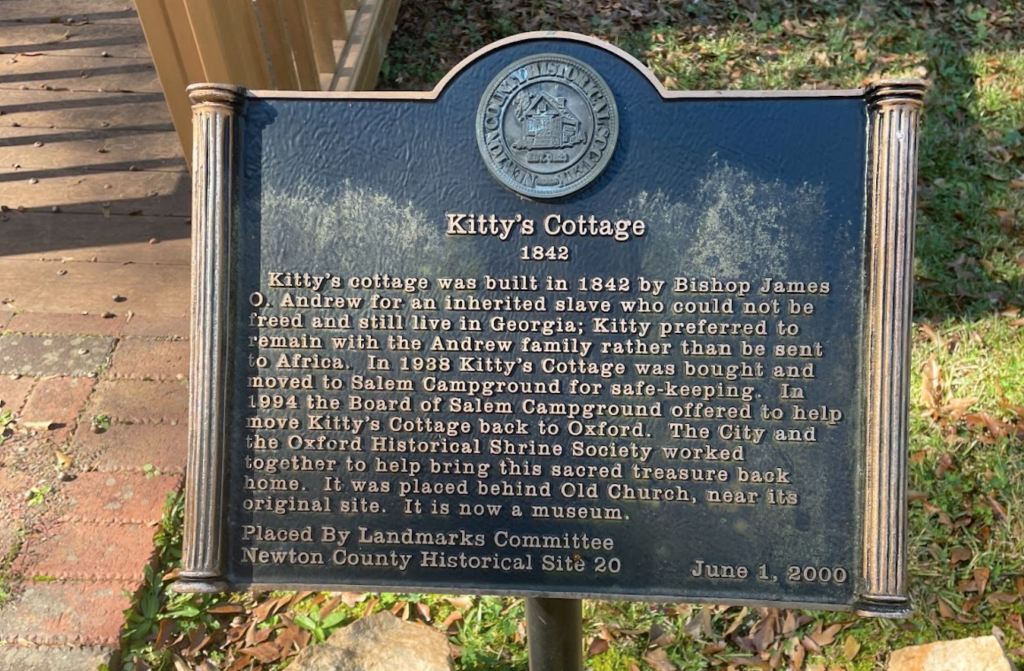
The sign posted outside of Kitty’s Cottage in Oxford, Ga. (Eva Roytburg)
Some students and community members said they have qualms with this narrative.
“When I first read the sign in front of Kitty’s Cottage, I definitely thought it was a very white-washed account of the events that transpired,” Gee said. “The sign outside isn’t appropriate to the story that actually happened because it’s clear Catherine didn’t have much of a choice in terms of leaving.”
Auslander, who wrote a book that discusses the various retellings of Boyd’s story, said the focus on Boyd in the city of Oxford perpetrates a “culture of denial” about the horrors of slavery in the South.
“Kitty became famous because, supposedly, she refused to be freed,” Auslander said. “The implication of those many narratives which have been printed and retold hundreds and hundreds of times over the last 150 years was that Miss Kitty illustrated a principle that slavery wasn’t so bad, that a person could choose to remain in slavery.”
There was reason to believe that the story of Catherine’s devotion to Andrew’s family was “shading the truth,” Auslander explained.
“Bishop Andrew always claimed that he inherited Miss Kitty from a widow in Augusta, Georgia, but that person didn’t exist,” Auslander said. “There’s nothing in any of her probate records that indicates that she in any sense transferred Miss Kitty to Andrew.”
Additionally, when Andrew was called to the national Council of Bishops in the Methodist Church to discuss his slave ownership with the church leaders, Auslander said that Andrew tried to hide how many slaves he owned by transferring them to former Emory President Augustus Longstreet.
Not everyone, however, views the cottage in a negative light.
“I do think there is another way of looking at [Kitty’s Cottage] beyond just the story itself,” Gee said. “While I may have some mixed emotions about it, I do want to
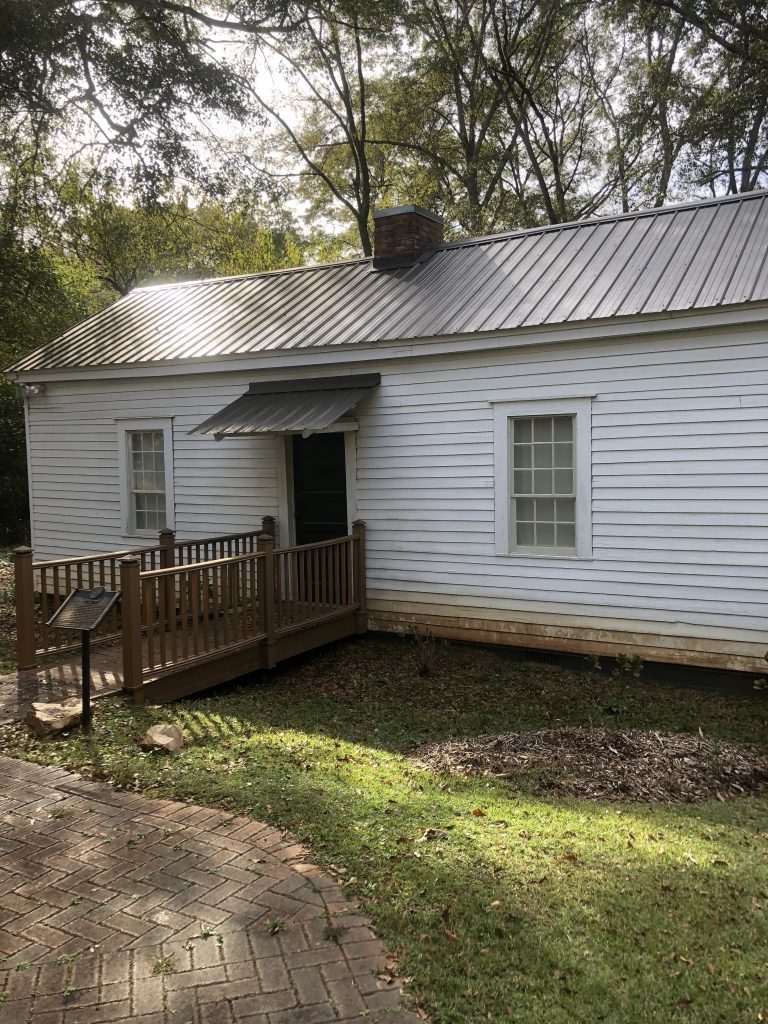
Kitty’s Cottage, which is located near the College’s campus in Oxford, Ga., is the former house of Katherine “Kitty” Andrew Boyd, who was enslaved at 12 years old by Methodist Bishop James Osgood Andrew. Andrew was the first chair of the Emory Board of Trustees. (Josh Kravath)
acknowledge that other people have different ways of reflecting on it that are completely valid as well.”
Perhaps no one has as deep of a relationship with the cottage as Cynthia Martin, Boyd’s 3rd-great-granddaughter. Martin wrote in a Jan. 18 email to the Wheel that her experiences visiting the cottage were “once overwhelming, and now fulfilling and heartwarming.”
“I am humbled and appreciative by the cottage’s preservation,” Martin said. “I’d like to think when others go to Kitty’s cottage, they are inspired to reflect on their own slave ancestors’ lives and pay their respect or to simply acknowledge slavery’s role in our shared Oxford and Emory history.”
As a friend of Martin, former Oxford City Council member Avis Williams (78Ox, 98C, 08T, 18T) experienced the cottage as a place of reflection during their visit together in September 2021, describing it as a “holy moment” with Catherine Boyd’s spirit.
“[Martin] was able to introduce her ancestor to us,” Williams said. “It was very moving and brought us all to tears. At that moment, it superseded anything that might be on that plaque outside.”
However, Martin also recognized the importance of telling an honest narrative, writing that she’d, “like to see the narrative surrounding her changed to reflect what we know about her and keep conjecture to a minimum. The plaques and signage outside the Cottage should also be changed to more fact-based.”
Williams further highlighted the importance in changing the signage.
“We need to be liberal in our thinking and fair in our presentation,” Williams said. “It’s the task of Emory and others to tell the whole story.”
Auslander also thought Oxford had not yet demonstrated leadership by facing up to Boyd’s memory.
“I think the relative disinterest in Miss Kitty’s cottage is a symptom of disengagement by the College and also a symptom of the College’s disengagement from surrounding Newton County, especially Black Newton County,” Auslander said. “This is a key point about a larger disengagement from much of Emory University about dealing with its low-income neighbors.”
Controversy in Covington
Troubling commemorations extend into the neighboring town of Covington, just two miles from the Oxford campus. A Confederate monument looms tall in the town square, a central hub in the small city and a popular meeting spot for Covington residents and Oxford students.
Installed in 1906, the monument depicts a Civil War soldier standing on a square base, his hands on his gun’s muzzle. The base is decorated with rifles, swords, an anchor and a Confederate flag. Its text reads, “To the Confederate dead of Newton County … And mark the tombs where valor lies.”
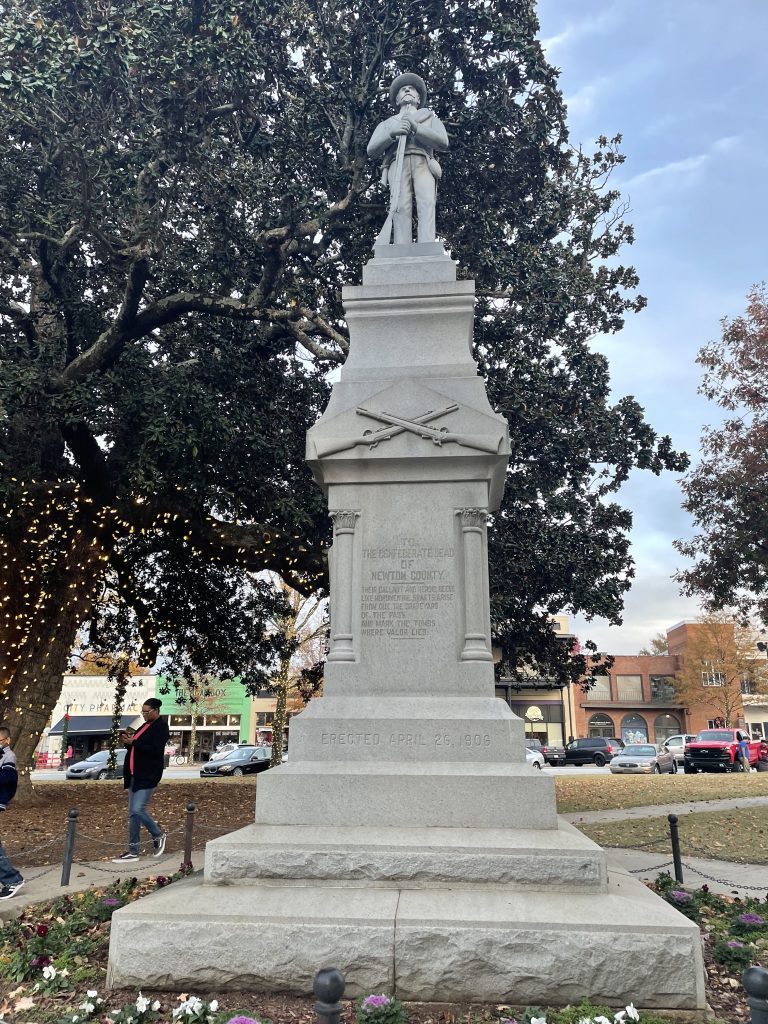
The statue in Covington Square which was installed in 1906 pays tribute to “the Confederate dead of Newton County.” The Newton County Board of Commissioners voted to remove the statue in July 2020, and the case has been appealed to the state’s supreme court. (Eva Roytburg)
The statue has long been a source of unease for Black community members, long term residents said. Williams, who grew up in Covington, recalls her and other Black children being told to avoid the square due to the Ku Klux Klan rallies that used it as a gathering point.
As a result, Williams said that she avoided the square for most of her life, estimating that she was over 50 when she first stepped foot on the inner part of the square where the statue stands.
Williams believes that many of the statues scattered throughout the South that glorify the Confederacy need to be removed.
“Sometimes when I go through the town square, there are people — young people t00 — worshiping and praying at the statue, wanting the old ways to come back,” Williams said. “It’s hard to believe there are people in the 20th century who don’t have an issue with human bondage.”
Similarly, Oxford Black Student Alliance (BSA) President Sarah Bekele (22Ox) recalled the discomfort she felt when driving through Covington last year. Gathered around the statue, a number of people, including families with small children, were waving American and Confederate flags.
“That was one of the first times I’ve ever felt super uncomfortable in my skin,” Bekele said. “I was really, really hoping that nothing was going to happen.”
The statue has received more backlash in recent years. Following the nationwide protests for racial justice in summer 2020, Covington residents renewed attention on the statue. Community members circulated a petition calling for the removal of the monument, which has 11,906 signatures as of Jan. 14.
Despite renewed attention, not all community members feel the same urgency to remove the monument. Newton County resident Bill Nash helped organize a rally in the square last April in favor of keeping the statue up, according to the Covington News. About 60 people attended to hear speeches advocating for protecting the statue.
The protests showed how many Covington residents take pride in their relationship with the Confederacy, Covington native Kirsten Oglesby (23Ox) said.
“People were surrounding the statue and said, ‘No, you aren’t taking us down. This is my history. If you want to take this down, you have to go through me,’” Oglesby said. “It shows how a lot of people are willing to go, as far as practically risking their lives to protect the Confederacy.”
Tom Spigolon, the news editor for the Covington News who reported on the statue’s controversy, said the Newton County Board of Commissioners decided to take action on removing the statue following the protests.
The board voted 3-2 to remove the statue in July 2020. Since then, legal injunctions have been filed to prevent its removal. Newton County’s Appeals Court and Superior Court ruled in favor of the board’s position on July 22, 2021 and Sept. 14, 2020, respectively. The case was appealed again and is currently in the Supreme Court of Georgia.
According to Bryan Fazio, the public information officer for Newton County, the county is waiting for the appeal process to play out before taking the next step as of Dec. 1.
Hauk said that the memorial emblemized “the sort of ‘lost cause’ sentiment that is common for those who served in the Confederacy.”
Gee agreed, believing that the discourse over the statue represented more than just the statue itself.
“Even if the statue is successfully removed, the people who support it will still have the same mindset,” Gee said. “The difficulty to remove it is definitely sad and telling of the area that we live in.”
Addressing discomfort
With testaments to the Confederacy still present in and around Oxford’s campus, students have sought to change the school’s historical narrative and make their concerns clear to Oxford College administrators.
Led by Bekele and Gee, Oxford BSA developed a list of ideas for how the school could better acknowledge its history. Some of the suggestions included incorporating acknowledgements of Emory’s history with slavery into orientation, including students in the decision making for what is on plaques outside of the cemetery and Phi Gamma Hall, and having the plaques be visible on virtual tours.
Bekele and Gee presented this information to Oxford Dean of Campus Life Joseph Moon and Oxford Director of Student Involvement and Leadership Rhiannon Hubert in a meeting on Nov. 18.
Gee was optimistic following the meeting, noting that Moon and Hubert were receptive to feedback and seemed willing to make changes.
Some students believe more signage is needed around campus to explain the historical significance and implications of locations with ties to slavery or the Confederacy. The BSA initiative suggested a student and faculty commission to write these panels to ensure the narrative is not white-washed.
Additionally, some also requested more transparency regarding Oxford’s ties to slavery and the Confederacy. They feel there is no easily accessible place for incoming students to learn about this history and know to expect relics of the Confederacy when they get to campus.
Bekele said providing this information should not fall on students, but rest on the administration.
BSA also requested that the school clearly acknowledge the labor from enslaved persons that contributed to constructing Oxford campus buildings, including Phi Gamma and Few Hall, now part of Oxford’s Tarbutton Hall. Students also suggested that this acknowledgement be implemented into future first-year orientations.
Director of Communications at Oxford College Carrie Harmon wrote in a Jan. 18 email to the Wheel that former University Provost Dwight McBride and Hicks acknowledged that enslaved labor played a role in constructing Phi Gamma Hall during its 2018 dedication.
“Since then, the Task Force on Untold Stories and Disenfranchised Persons and the Twin Memorials Working Group have focused our university efforts, including Oxford College, on the work of continuing to recognize and memorialize the contributions of disenfranchised groups on both campuses,” she wrote.
In response to this feedback, Hubert is initiating an evaluation of Oxford’s New Student Orientation to review structure and content.
Planning for the 2022 orientation is still in its early stages, but Hubert told the Wheel that the orientation committee plans to invite student representation to meetings once they start. Additionally, the committee plans to meet with various stakeholders throughout the spring, including student groups and support offices, to revise the orientation’s goals and outcomes.
“We have to make room to intentionally rethink how we introduce new students to Oxford and Emory,” Hubert said. “I believe we have the opportunity to introduce students to Emory’s history early, and with that, offer space for processing, reflection, support and connection.”
Oxford has previously made attempts to reconcile with the legacy of slavery and the Confederacy. During the University’s “In the Wake of Slavery and Disposession” symposium on Oct. 5, the College hosted a conversation entitled “The History of Oxford and Where We are Today.” The event focused on the impact that Emory’s racial legacy left on students. Hicks, Gee and Bekele spoke at the event.
“Events like the symposium are about telling the whole story, but then one needs to act on what was said,” Williams said. “Action items that come out of it need to be teaching tools for young people because discriminatory thinking isn’t something you’re born with.”

